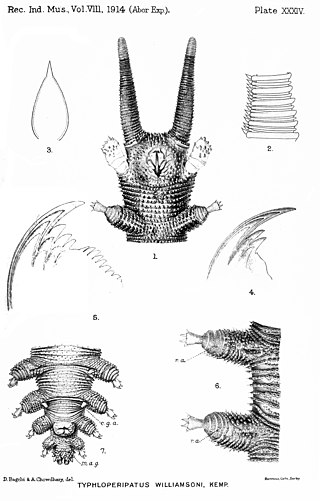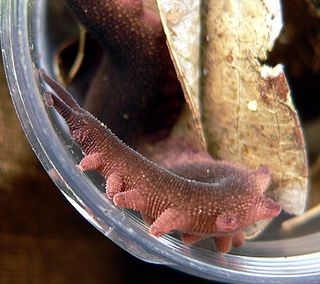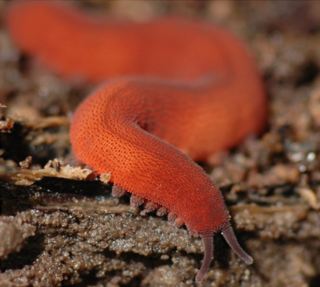
Peripatus is a genus of velvet worms in the Peripatidae family. The name "peripatus" is also used to refer to the Onychophora as a whole, although this group comprises many other genera besides Peripatus. The genus Peripatus is found in Central America, the Caribbean and northern South America. This genus is viviparous, with mothers supplying nourishment to their embryos through a placenta.

Typhloperipatus is a genus of velvet worm in the family Peripatidae, containing the sole species Typhloperipatus williamsoni. This genus is notable for containing the only species in the phylum Onychophora found in South Asia. This species is also striking in that this velvet worm shows no external trace of eyes, although rudimentary optical vesicles are present internally.

Eoperipatus is a genus of velvet worms in the family Peripatidae. These velvet worms have been reported from locations throughout Southeast Asia, including Malaysia, Singapore, Thailand, and Vietnam. This genus exhibits lecithotrophic ovoviviparity; that is, mothers in this genus retain yolky eggs in their uteri.

Epiperipatus is the most diverse genus of neotropical velvet worms in the family Peripatidae. Species in this genus are found in Central and South America. This genus is viviparous, with mothers supplying nourishment to their embryos through a placenta.

Oroperipatus is a genus of Neotropical velvet worms in the family Peripatidae. Species in this genus are found in South America west of the Andes and in Mexico. This genus is viviparous, with mothers supplying nourishment to their embryos through a placenta.

Eoperipatus totoro is a species of velvet worm of the family Peripatidae. This species is notable as the first velvet worm from Vietnam to be formally described. As of 2023, E. totoro remains the only species of velvet worm from Vietnam to be described.
Epiperipatus cratensis is a species of velvet worm in the family Peripatidae. This species is found in northeastern Brazil. This velvet worm is notable as a small species of Epiperipatus with many legs.
Oroperipatus belli is a species of velvet worm in the Peripatidae family. The female of this species has 28 pairs of legs; the male has 25 pairs. The type locality is in Ecuador.
Oroperipatus bluntschli is a species of velvet worm in the Peripatidae family. The original description of this species is based on a female specimen measuring 100 mm in length; its 40 pairs of legs are notable for approaching the maximum number (43) recorded in velvet worms. The type locality is in Peru.
Oroperipatus ecuadoriensis is a species of velvet worm in the Peripatidae family. The original description of this species is based on a female specimen notable for its large size ; this description also reports 39 pairs of legs. The type locality is in Ecuador.

Oroperipatus eisenii is a species of velvet worm in the family Peripatidae. Females of this species have 27 to 29 pairs of legs, usually 28; males have 23 to 26. Females range from 30 mm to 57 mm in length, while males range from 20 mm to 23 mm. The type locality is found in Brazil and central Mexico.
Oroperipatus peruvianus is a species of velvet worm in the Peripatidae family. Males of this species have 34 pairs of legs; females have 36 or 37. Female specimens range from 55 mm to 61 mm in length. The type locality is in Peru.
Peripatus dominicae is a species of velvet worm in the Peripatidae family. The type locality for this species is on the Caribbean island of Dominica. Although the Canadian zoologist Stewart Peck introduced the name Peripatus dominicae dominicae in 1975 to distinguish the original species from other subspecies then assigned to P. dominicae, authorities now deem these subspecies to be separate species in light of the significant distances between their type localities.
Peripatus evelinae is a species of velvet worm in the Peripatidae family. The male of this species has 33 pairs of legs; females have 35 or 36 leg pairs. This species has more legs than any other species of Peripatus; the females of the other species have at most 34 leg pairs, and the males have at most 32. The original description of P. evelinae was based on two specimens and reported females with 32 and 34 leg pairs, but another examination of these specimens revealed a male with 33 leg pairs and a female with 35 leg pairs instead as well as numerous embryos, including females with 35 and 36 leg pairs. The male specimen is 44 mm long; the female is 65 mm long. The type locality is in Goiás, Brazil.

Peripatus juanensis is a species of velvet worm in the Peripatidae family discovered in Puerto Rico in 1900. As of 2018, it is the only velvet worm found in Puerto Rico. Females of this species have 31 or 32 pairs of legs; males have 27.
Mongeperipatus solorzanoi, also known as Solórzano's velvet worm, is a species of velvet worm in the family Peripatidae. This species is the largest known velvet worm, reaching 22 cm in length. This velvet worm is found in the Caribbean coastal forest of Costa Rica.
Mongeperipatus is a genus of velvet worms in the family Peripatidae from Costa Rica. The biologists José Pablo Barquero-González, Steven Sánchez-Vargas, and Bernal Morera-Brenes introduced this genus in 2020 to contain the newly discovered type species, M. kekoldi, together with another species, M. solorzanoi. A phylogenetic analysis using DNA sequences placed these two species in their own monophyletic clade. Furthermore, these two species share morphological characters that indicate that these species do not belong in the other genera and instead belong together in a separate genus. The genus Mongeperipatus is named in honor of the Costa Rican biologist Julián Monge-Nájera.
Epiperipatus hyperbolicus is a species of velvet worm in the family Peripatidae. This velvet worm is known only from its type locality in the state of Alagoas in Brazil. The species name refers to the unusually large apical piece on the primary papillae on this velvet worm. This distinctive apical piece is notable for its size and spherical shape. The males of this species have 23 pairs of legs; females have 24 or 25 pairs.
Epiperipatus titanicus is a species of velvet worm in the family Peripatidae. This velvet worm is known only from its type locality in the state of Alagoas in Brazil. The species name refers to the large size of its females and its numerous legs. This species features more legs than any other Brazilian species of velvet worm.
Oroperipatus tiputini is a species of velvet worm in the Peripatidae family.






